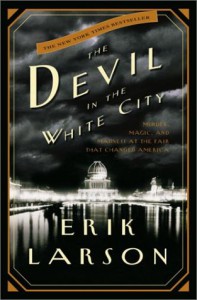The Devil in the White City

The story of the World's Columbian Exposition (the 1893 Chicago World's Fair) and the events surrounding it are fascinating. It is these events and the shocking details surrounding H.H. Holmes that likely lead so many people to love this book. It is the sort of story many novelist would have loved to have devised themselves. Unfortunately, while the story is interesting, too much of The Devil in the White City rests on speculation, and this left me uncomfortable.
Again we approach that line of defining fiction and non-fiction. Does it matter if a work of non-fiction takes liberties? Probably not. But the issue is that when a storyteller purports to tell the truth, one expects the truth. All further additions are distracting. Personally, I enjoy these narrative non-fictions that add color and flavor to the traditional textbook story. I'm okay with some flair. Where I become uncomfortable is when the author adds thoughts and actions to “characters” he couldn't possibly know, especially in regards to their final moments. The actions and last thoughts of Holmes' victims are cemented forever by Larson's speculations. The lack of distinction between truth and fiction was troubling. In the conclusion Larson labels some of these speculations and tries to provide rationale for their inclusion, but it changed nothing for me.
Were Larson's inventions style or lack of material? It could've been either, but I do think there is a certain lack of solid material for the book. It felt as though the author was grasping at any threads he could build his book from. Had Larson stuck with what he knew from historical records, I get the feeling that the sections on Holmes in particular would've been thin. And without Holmes, this book wouldn't be the success it has become.
In the end, I credit Larson for uncovering a brilliant story and knowing how to make it interesting for the masses. Even removing the serial killer aspect of the story, The Devil in the White City is captivating; in truth, I'd say I found other aspects of the Fair much more interesting, in particular the Ferris wheel and the landscape architecture of Olmsted.
 4
4



